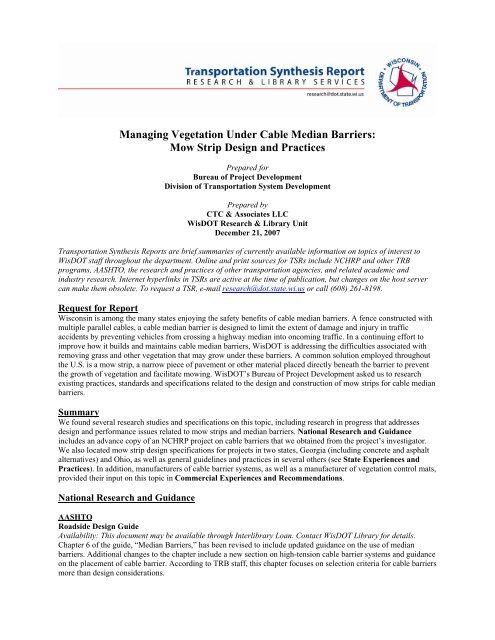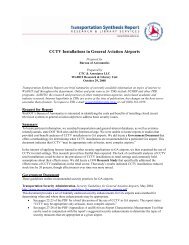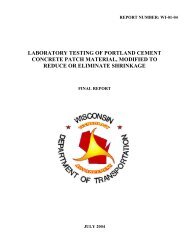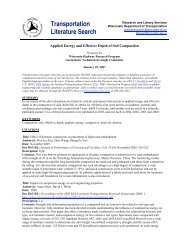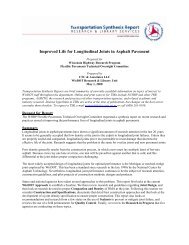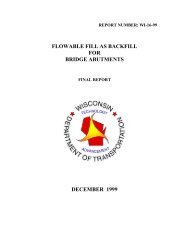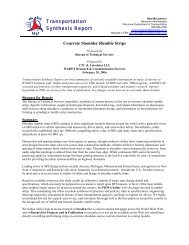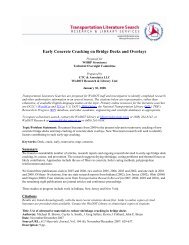Mow Strip Design and Practices - WisDOT Research
Mow Strip Design and Practices - WisDOT Research
Mow Strip Design and Practices - WisDOT Research
Create successful ePaper yourself
Turn your PDF publications into a flip-book with our unique Google optimized e-Paper software.
AASHTO Technology Implementation GroupCable median barriers are a focus technology for AASHTO’s Technology Implementation Group. Resources relatedto barrier design, roadway design <strong>and</strong> maintenance are available athttp://tig.transportation.org/?siteid=57&pageid=2197.National Cooperative Highway <strong>Research</strong> ProgramNCHRP has two projects in progress related to st<strong>and</strong>ard practice for cable barrier design, construction <strong>and</strong> use.Project 20-07, Task 210, “Guidelines for the Selection of Cable Barrier Systems”http://www.trb.org/TRBNet/ProjectDisplay.asp?ProjectID=1226Principal investigator Dean Alberson of the Texas Transportation Institute provided us with the draft final report forthis project, which we are providing as a separate document as it has not yet been approved for public distribution.The project’s purpose was to “develop preliminary guidelines for the selection <strong>and</strong> use of cable barrier systemsbased on a state-of-the practice review of cable barrier installations.” NCHRP’s administrative contact for this studyis Charles Niessner.The report references issues related to mow strips, including common practices <strong>and</strong> design issues:Extent of useBased on the investigators’ survey of state DOTs: “When asked if the participating states used mow stripsunderneath the cable barriers, 44% replied positively (27 responses were received). Some of these states alwaysuse mow strips with cable barriers, while others have used them intermittently. One of the states indicated thateven though they have experimented with using mow strips in the past, their current preference is not to usethem. One of the states indicated that the decision to use mow strips is left to the designer <strong>and</strong> another indicatedusing mow strips when the budget allowed. Most states use asphalt mow strips. One of the states indicated usingconcrete mow strips <strong>and</strong> another indicated using coarse aggregate” (page 39 of the PDF).Typical geometry“Participants were also asked about the typical width <strong>and</strong> thickness of the mow strip used in their states. Fiveout of seven states that responded indicated using a 4-ft-wide strip. One state indicated using 6-ft-wide strips<strong>and</strong> another indicated using 2- to 4-ft-wide mow strips. Two of the six responding states indicated using 2-inchthickmow strips <strong>and</strong> the remaining four indicated using 4-inch-thick mow strips” (page 39 of the PDF).Use with socketed posts“A number of states have elected to install socketed systems that facilitate repair of the system, <strong>and</strong> whencoupled with a mow strip, they simplify mowing operations. Continuous mow strips have also eliminated socket<strong>and</strong> anchor movements in weaker soil conditions” (page 12 of the PDF). The report details the socketed design(pages 61-62) <strong>and</strong> compares state use of socketed versus driven posts (page 37).Project 22-25, “Development of Guidance for the Selection, Use, <strong>and</strong> Maintenance of Cable Barrier Systems”http://www.trb.org/TRBNet/ProjectDisplay.asp?ProjectID=1640This project will address the “need to formulate guidelines <strong>and</strong> st<strong>and</strong>ardized practices for cable barrier systems.”This project is a more comprehensive follow-up to Project 20-07, Task 210 (above), <strong>and</strong> will address design,construction <strong>and</strong> performance issues in detail. The status of this project is listed as pending on the TRB Web site.NCHRP administrative contact Charles Niessner told us that a contractor has not yet been selected.Contacts:Charles Niessner, NCHRP Senior Program Officer, (202) 334-1431, cniessner@nas.edu.Dean Alberson, TTI Crashworthy Structures Program, (979) 458-3874, d-alberson@tamu.edu.2
State Experiences <strong>and</strong> <strong>Practices</strong>The information below includes details collected from several state DOT representatives. In addition, Illinois DOT’sHigh Tension Cable Median Barrier: A Scanning Tour Report(http://tig.transportation.org/sites/aashtotig/docs/High%20Tension%20Cable%20Median%20Barrier%20-%20Scanning%20Tour%20Report.pdf) describes installation experiences in Ohio, Oklahoma <strong>and</strong> Texas; we provideexcerpts of these descriptions by state below.GeorgiaA contract addendum for a highway project in Georgia’s Franklin <strong>and</strong> Hart counties contains specifications for apaving strip under the cable barrier. It provides two alternatives: a 6-foot-wide Superpave-compliant asphalt strip ora 4-foot-wide Class A concrete strip. Detailed drawings are attached as Appendix A to this synthesis report (pages 4<strong>and</strong> 5 of the file at http://tomcat2.dot.state.ga.us/ContractsAdministration/uploads/c002a01-061020.pdf).OhioOhio DOT St<strong>and</strong>ards Engineer Dean Focke said that for a recent Ohio DOT cable barrier project, a plan sheetdetailed the construction of the paved mow strip, referred to as a “paved berm.” This plan sheet is attached asAppendix B to this synthesis report.Contact: Dean Focke, dean.focke@dot.state.oh.usAccording to the Illinois scan tour report (see pages 17-18 of the PDF), 3 miles of cable barrier system werecompleted in Ohio in October 2004: “The barrier was placed at the edge of the paved shoulder on an asphalt mowstrip. Posts were installed in sockets with concrete foundations <strong>and</strong> spaced 10 feet with a design deflection of 7.9feet. … <strong>Mow</strong>ing <strong>and</strong> snow plowing are concerns that are recommended to be addressed at the design stage.”TexasFact Sheet: Cable Median Barriers, March 2007http://www.transportation.org/sites/aashtotig/docs/Texas%20-%20CMB%20Background%20<strong>and</strong>%20Facts%20%283-2007%29.pdfIn this fact sheet, Texas DOT reports that “Most districts are also placing mow strips with the cable barrier systemsfor maintenance considerations.”Memor<strong>and</strong>um: Cable Barrier Systems, June 2006http://www.transportation.org/sites/aashtotig/docs/Texas%20Cable%20Barrier%20Systems%20Memo%20%282006%29.pdfIn this memo on cable barrier systems, TxDOT notes that “future mowing requirements” are a factor to considerwhen selecting whether to use a cable barrier (see page 1 of the PDF).Further, “the Maintenance Division encourages the use of mow strips to reduce future h<strong>and</strong> mowing or herbicideoperations. Distance between the edge of the travel lane <strong>and</strong> the cable barrier should consider mower widths. Thesame consideration apply to distances between the cable barrier <strong>and</strong> other objects such as the guardrail, bridgecolumns, <strong>and</strong> end treatments” (page 5 of the PDF).“Power Curber 5700-B Accelerates Median <strong>Mow</strong> <strong>Strip</strong> Installation,” Texas Contractor, January 2007http://www.acppubs.com/article/CA6403748.htmlThis article describes the installation of 45 miles of mow strip for a cable barrier system in Texas. The process isdescribed in detail: “In the slipform application, the holes for the posts are bored first at marked locations on theinterstate. Then, the mow strip is slipformed, with concrete filling the holes. … The posts are then inserted into thewet concrete <strong>and</strong> the wire cable is installed for the Safe Roads, LLC U.S. high-tension cable system.”In addition, the Illinois scan tour report describes an installation in Texas: a 4-foot-wide by 3-inch-thick asphaltmow strip designed “to help reduce cable barrier maintenance. It is believed that the strip also makes cable barriermore noticeable for first responders, who may suddenly need to cross the median in the case of an emergencysituation…. It was recommended to control the water level at the mow strip to avoid premature asphalt deterioration<strong>and</strong> additional maintenance. Even though cable barrier doesn’t need to be mowed because of the asphalt strip,TxDOT protects the installation from damages caused by mowing contractors by charging them $100 per postdamaged” (page 27 of the PDF).3
A 2004 letting schedule for Texas’ Beaumont District includes line items for the installation of a cable barrier <strong>and</strong>mow strip in two counties (see http://www.txdot.state.tx.us/insdtdot/orgchart/cmd/cserve/let/2004/letbmt.htm).TxDOT <strong>Research</strong>The Texas Transportation Institute (part of Texas A&M University) conducts a significant amount of roadside safetydevice research. Two recent reports for TxDOT by TTI Roadside Safety Program investigator Roger Bligh addressthe topics of mow strips <strong>and</strong> cable barriers, although not as they relate specifically to each other.• The 2006 report “Median Barrier Guidelines for Texas” makes a minor reference to mow strips, indicating thatfurther research is needed on “whether a concrete or other type of mow strip [is] cost-effective.” Seehttp://tti.tamu.edu/documents/0-4254-1.pdf (page 85 of the PDF).• Two reports from 2004, “Dynamic Response of Guardrail Systems Encased in Pavement <strong>Mow</strong> <strong>Strip</strong>s”(http://tti.tamu.edu/documents/0-4162-2.pdf) <strong>and</strong> “Evaluation of Roadside Safety Devices Using Finite ElementAnalysis” (http://tti.tamu.edu/documents/0-1816-1.pdf) detail many mechanical <strong>and</strong> technical aspects of mowstrip installation <strong>and</strong> response, but specifically for guardrails rather than cable barriers.We contacted Roger Bligh to determine what additional research is planned or in process related to mow strips forcable barriers. He told us that since cable barriers are a “weak post system,” he believes there is not a greatconsequence in crash response for embedded posts by the addition of a mow strip. He said the decision to use mowstrips also involves operations decisions (limiting worker exposure by reducing h<strong>and</strong>-mowing) <strong>and</strong> life cycle costs(including mow strip installation costs, post replacement costs with a mow strip in place, <strong>and</strong> savings from reducedmowing). He was not aware of a formal cost analysis on this topic.Contact: Roger Bligh, TTI Roadside Safety Program, (979) 845-4377, rbligh@tamu.edu.FloridaRoadway <strong>Design</strong> Bulletin, “High Tension Cable Barriers,” 2007-08http://www.dot.state.fl.us/rddesign/updates/files/RDB07-08.pdf (page 5 of the PDF)In this bulletin, Florida DOT provides limited specifications for mow strips for high-tension cable barriers: “Unlessdetermined otherwise by the District, place a 3-foot-wide 2-inch-thick miscellaneous asphalt mow strip under thecable barrier, similar to that used for the guardrail. The mow strip should be centered along the cable barrieralignment. Since no st<strong>and</strong>ard index drawings have been issued at this time, the mow strip must be detailed in theplans.”FDOT’s general requirements for mow strips, not specifically related to cable barriers, call for “miscellaneousasphalt”—any approved asphalt mix except open graded friction course—at 3 feet wide by 2 inches deep.Specifications for miscellaneous asphalt are detailed athttp://www.dot.state.fl.us/specificationsoffice/2007BK/339.pdf.IllinoisSpecial Provision for High Tension Cable Median Barrier, September 2006http://www.dot.il.gov/desenv/pdf/80169.pdf (page 3 of the PDF)Illinois provides this construction requirement: “When the barrier is to be placed within paved shoulders or mowstrips, the paved area(s) shall be constructed first <strong>and</strong> the concrete foundations placed in cored or formed holes.”Nebraska<strong>Design</strong> St<strong>and</strong>ards Engineer Phil TenHulzen from the Nebraska Department of Roads provided the state’srequirements for mow strip installations used with cable median barriers: 3 feet wide by 5 inches deep, usuallyconstructed from asphalt at $27–$31 per square yard. Detailed material specifications are the same as those used forguard rails, listed in Appendix C.Contact: Phil TenHulzen, (402) 479-3951, ptenhulz@dor.state.ne.us.IndianaIndiana DOT <strong>Design</strong> Policy Engineer Richard VanCleave told us that although INDOT does not require or providespecifications for a mow strip under cable barriers, it advises designers that using some form of “vegetation controlstrip” would be appropriate to avoid unintended lawnmower contact with the barriers. INDOT suggests that4
vegetation control strips might consist of either hot-mix asphalt, at 4 feet wide by 3 inches thick, or commerciallyavailable sheet roll materials rolled out flat along the length of the barrier to suppress vegetation growth. He notedthat some think that vegetation control strips might also enhance the visual awareness of the cable median barrier formotorists who choose to cross the median in emergency situations, thus preventing unnecessary impacts.Contact: Richard VanCleave, rvancleave@indot.in.govOklahomaAccording to the Illinois scan tour report, “mow strips have been placed under [cable barriers] in two installations,but Oklahoma DOT does not believe it is essential for the cable systems in all projects” (page 21 of the PDF). ForLake Hefner Parkway in Oklahoma City, Oklahoma DOT built a mow strip 4 feet wide by 4 inches thick under thecable system. It determined that this was “not effective since h<strong>and</strong> mowing is still needed. A soil herbicide ismentioned as a possible solution” (page 23 of the PDF).Commercial Experiences <strong>and</strong> RecommendationsWe contacted major manufacturers of cable median barriers, as well as one manufacturer of a rubber mat thatsuppresses vegetation growth, who provided their experiences <strong>and</strong> recommendations.Trinityhttp://www.highwayguardrail.com/Cable barrier manufacturer Trinity Highway Products LLC recommends the use of an asphalt strip 3 to 4 feet wideby 3 to 4 inches deep. Trinity’s Rick Figlewicz told us that asphalt mow strips have been used in instances where thesoil was poor <strong>and</strong> the strip could serve the additional purpose of providing added supporting foundation for theposts.Contact: Rick Figlewicz, (847) 638-4611.Brifenhttp://www.brifenusa.com/Cable barrier manufacturer Brifen reported that it had used a 4-foot-wide by 4-inch-thick asphalt mow strip for aninstallation in Oklahoma, but that the solution proved to be “unsatisfactory because the area still had to be h<strong>and</strong>mowed.”Contact: (405) 751-8062Weed Mat by TrafFix Deviceshttp://www.traffixdevices.comTrafFix Devices Inc. manufactures a product called Weed Mat, a crumb rubber mat made from 100 percent recycledtire rubber designed to prevent the growth of foliage around guardrail <strong>and</strong> cable barrier systems. Each 40-pound matis 1/2 inch deep <strong>and</strong> 2 feet wide; mats interlock in a series as shown in the figure below. Weed Mat specificationsare attached as Appendix D.Contact: Dave Lindquist, TrafFix Midwest Regional Sales Manager, (630) 406-0760.A series of six interlocking Weed Mats.For more information on the use of rubber tiles to prevent vegetation growth, see Texas DOT’s Tire Rubber Anti-Vegetation Tile Evaluation Project at http://www.dot.state.tx.us/services/general_services/recycling/tile.htm.5
Appendix B: Ohio DOT cable barrier plan sheet with “paved berm” detail8
Appendix C: Nebraska Department of Roads specifications for surfacing under guardrailsSURFACING UNDER GUARDRAIL (E-3-0307)Amend Section 503 in the St<strong>and</strong>ard Specifications to include SurfacingUnder Guardrail.At the contractor's option, the surfacing may be constructed usingClass "47B-3000" Concrete, Class "AX-3000" Concrete, Class "PR-3000"Concrete (Class 47B-20 Concrete, Class AX-20 Concrete, Class PR-20Concrete), or any commercially produced hot mix asphaltic concrete, whichhas been approved by the Engineer. These materials may be usedinterchangeably during the course of the work except that surfacing at anyindividual location must be completed with the same material with which thework was begun.If concrete is used in the surfacing, it shall reach a minimumstrength of 3000 psi (20 Mpa) before opening to traffic.Amend Subsection 302.04 in the St<strong>and</strong>ard Specifications to providethat the work of subgrade preparation for surfacing under guardrail willnot be measured for payment, but shall be considered subsidiary to the item"Surfacing Under Guardrail".Subsection 503.05 in the St<strong>and</strong>ard Specifications is amended toprovide that P.G. binder used in the asphaltic concrete will not bemeasured for payment, but shall be considered subsidiary to the item"Surfacing Under Guardrail".Subsection 504.04 in the St<strong>and</strong>ard Specifications is amended toprovide that the application of a tack coat, including furnishingemulsified asphalt, will not be measured for payment, but shall beconsidered subsidiary to the item "Surfacing Under Guardrail".The work <strong>and</strong> materials required for any drainage curb placed onsurfacing under guardrail will not be measured <strong>and</strong> paid for, but will beconsidered subsidiary to the item "Surfacing Under Guardrail".The work <strong>and</strong> materials required for surfacing under guardrail will bepaid for at the contract unit price per square yard (square meter) for theitem "Surfacing Under Guardrail". Payment will be full compensation forthe work prescribed in these Special Provisions <strong>and</strong> the St<strong>and</strong>ardSpecifications.9
Appendix D: Weed Mat specificationsTrafFix Devices Weed MatThe intent of the following statements is to develop a specification for a crumb rubber mat, made from 100%recycled tire rubber. The Weed Mat is designed to prevent the growth of foliage around guard rail, <strong>and</strong> cable barriersystems.Dimensional RequirementsA. Overall Height: 48”B. Overall Width: 43.5”C. Weight per piece: 40 LBS.D. Thickness .5”Weed MatThe Weed Mat is manufactured from 100% recycled tire rubber. The Weed Mats will be compression molded at anelevated temperature with a binder agent added to create a strong, long lasting product. The color of the productwill be black.Weed Mats provide a skid resistant surface, as they are an adopted technology from the recreation industry <strong>and</strong> theworkplace, where they were used primarily for playground <strong>and</strong> work area safety surfacing. Weed Mats preventsunlight from reaching the ground surface, retarding seed germination. Weed Mats restrict water contact with theunderlying ground surface.10
Weed Mat InstallationThe TrafFix Devices Weed Mats are designed to work with existing guard rail <strong>and</strong> cable barrier systems, withst<strong>and</strong>ard 4” X 6” H beam vertical supports, or st<strong>and</strong>ard 6” X 8” or 8” X 8” wooden post vertical supports. TrafFixDevices Weed Mats have pre-formed locations for locating the vertical posts on center line, or offset. The offsetallows for the Weed Mat to be located closer to the road surface, or back, to cover additional areas behind the guardrail.The pre-formed shapes in the Weed Mat allow for easy trimming for use with either the H beam, or the wood postinstallations. For new guard rail <strong>and</strong> cable barrier installations, the Weed Mats can be set in place, <strong>and</strong> the H beamcan be driven through the Weed Mat. The overlap of each adjoining edges of the weed mats prevents foliage fromgrowing between adjoining Weed Mats.Optional method of securing the Weed Mat:The use of spikes to secure the Weed Mat can be used. The spikes, if used, should be driven through the Weed matat a convenient location near the edges, <strong>and</strong> corners of the Weed Mat. Spikes shall be made from long lastingmaterial. The head of the spike, or washer installed under the head, shall have a diameter of at least 1.25”. Spikesshall not cause splitting of the Weed Mat.The specifications of the local governing agency, <strong>and</strong> the specific application will determine the need for the useadditional anchoring.Adhesive CaulkingA bituminous / asphalt based adhesive caulking strip is factory applied to the lap strip of each Weed Mat. Duringinstallation, the adhesive caulking strip backing is removed from each Weed Mat. The Weed Mats are overlapped<strong>and</strong> the adhesive caulking strip bonds the adjacent Weed Mats. The bond provides a level of sealing between theWeed Mats, preventing lifting <strong>and</strong> water or dirt migration.Site PreparationAreas to receive Weed Mats shall be cleared of trash <strong>and</strong> debris. Vegetation shall be removed to the ground.Cleared trash, debris <strong>and</strong> removed vegetation shall be disposed outside the highway right of way.Prior to placement of Weed Mats, the sub grade surface shall be smooth, firm, stable <strong>and</strong> free of rocks, clods,foliage, roots or other material greater than 25 mm in diameter.11


